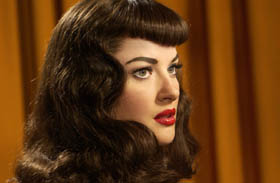Mol embodies pin-up queen in body, mind and spirit.
Calling the infamous Bettie Page “the first pin-up girl†is somewhat perplexing since the kind of picture-taking she was involved with would most likely not be in pinned up in plain view but instead hidden between two mattresses. Filmmaker Mary Harron creates the sort of biopic that doesn’t reveal the entire nature of its print friendly tigress, The Notorious Bettie Page is an interpretation of her life and an examination of her character through photos and archives – but is not the full picture. Harron poses the question of how Page became such an icon and she found that Gretchen Mol was best for answering that question.
Thoroughly researched and co-scripted with Guinvere Turner, Harron explores the character of Page one pose at a time, but before becoming a muse for many porn peddlers, the narrative explores how the symbol of naughtiness was an intelligent, religious person whose sense of morals was at odds with the repressed 50’s. Perhaps brunettes around the world owe Page for the inexistence of dumb “brunette†jokes.
What the film best explores is how she never lost those values when she was posing in the buff or with a whip in hand. The line in the film that best sums up her ideology and perception of others (these includes her obsessive fans) is as the bondage queen mentions on more than one occasion that “it takes all types to make this world†and that when God brought us into this world we came in without the constraints of clothes. Obviously Page was cursed by her good looks and ambiguously doomed by her naïve goodness but what made her an icon is perhaps not her curvaceous-ness but the simple fact that she was way ahead of her time.
Apart from Mol’s golden performance that embodies Page’s personality rather than impersonating it, the charm of the film is in the numerous photo-sessions sequences and how Harron tracks that 50’s timeline. Shot in black-and-white for almost the film’s entirety, Harron inter-cuts old stock footage of the era with re-imagined thoughts of how Page’s famed photo sessions came about. Interactive magazine covers, technicolor inclusions, screen wipes, iris fades and Super-8 visual playfulness bring viewers back to the era giving an accurate description of the time and place in history and surprisingly no commentary is made on her future history. Like a picture in a magazine – we can only guess to what the ending might be as Harron shaves off what would be a new chapter in Page’s own history books.
There are some rough spots in the narrative, there are some items (like pictures in any given photo session) that would have been better if they weren’t included – the pointless flashbacks in reference to the courts and the inventory of insignificant encounters with some figures add little to the trimmings and the slew of early life-altering incidents and its impact are combed over too quickly giving way to more details about the stay-at-home looking wife who was frolicking in front of the cameras.
As in I Shot Andy Warhol and American Psycho, Harron’s expertise is in exploring the mentality of an era but you’d aspire that there is a bigger statement to make about morality in America and how attitudes have hardly changed even if the material has. Here, Harron makes more of a statement about Americana and while on one hand The Notorious Bettie Page is a commentary about repression it also replicates the personality of the Bettie Page photo: it is rather tame and there is not much in terms of sizzle. While there might not be anything new to learn here and the fascination for such a figure unfortunately doesn’t make us follow-thru with our own research, this is perhaps best suited for those who’ve spent many hours over a poster pin-up memorizing every curve or for the legions of new and old fans of this high-heeled, black stockings, bare-breasted, best-looking-in-leather icon.
